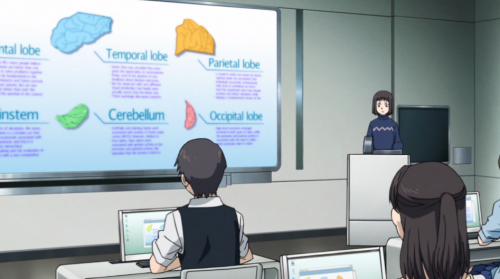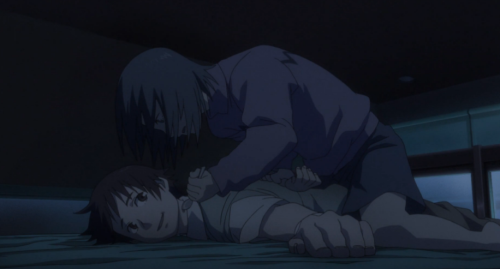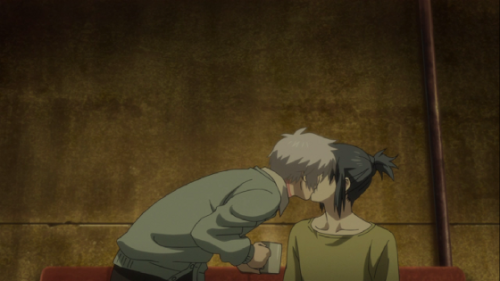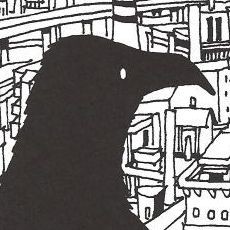(In my attempt to procrastinate a Haikyuu!! post I’ve been meaning to write for months, I present to you an excerpt from a final paper I wrote for one of my literary theory classes last year. Yeah, I’m that girl who always finds a way to connect her assignments to anime. No shame.)
In the anime and manga world, there have been countless debates on whether, No.6, a series by Atsuko Asano, is considered to be BL. BL, or boys love, is a genre of stories that depict romantic and sexual relationships between men. But although No.6’s main characters are both male, and they engage in acts that may be considered homosexual, Asano adamantly refuses the BL label. In her attempt to pull the series away from the charged label BL, Asano opens up the possibility of seeing it as queer. No.6 is a queer text because of its rejection of paranoid reading and exploration of nonsexual romance between men.
A Paranoid Fan:
Women active in writing fan fiction would be the extreme of a female paranoid fan; she is so anxious for her suspicions to come true that she takes the initiative to write it herself. And why does the usually heterosexual fan enjoy this kind of relationship? Because “BL emphasizes the pleasure felt by both the seme and the uke, juxtaposing panels of each face in a shot-reverse shot style” and “invites the reader’s identification with both partners”. Both the seme (aggressive, masculine role) and uke (passive, feminine role) roles have subjectivity, the subject giving love and the subject receiving love, unlike the usual heterosexual set up of the subject and the object of love. The female fan finds pleasure and is filled with agency when assuming the different roles, either as the viewer, the seme, or the uke.[1] The issue is that though “the gender representations and sexuality in boy-love manga challenge and trouble the belief that these categories are ontologically coherent, contained, and one dimensional- something that is at the very heart of queerness”, this queer-ing project has been taken up by fans that think that two guys looking at each other for more than two seconds must be homosexual, and it has become mainstream.[2] The constant search for the homosexual has done away with ideas of “bromance”, such a friendship between men has been flagged as homosexual. And it is into this kind of industry, one in which interactions between men have been flattened by the fans of the very genre that is trying challenge such actions, that No.6 was born.
Asano and Her Attempt to Work outside the Box:
No.6 is a science fiction story that takes place in a post-apocalyptic, dystopian world. Social-economic ranking depends on IQ (more specifically, a test the citizens take when they are 2 years old) and the society garners those natural abilities, structuring a hierarchy where those with more intelligence are much better off than and those who lack it. The first episode puts emphasis on the bracelet ID’s, often zooming in when Shion, the protagonist, passes checkpoints. Following the “big brother is watching” society archetype, No.6’s “Moon Drop” keeps a very close and extremely strict watch on its citizens. The first scene in the series resembles the scenario mentioned in Foucault’s The History of Sexuality. Shion is seen in a classroom, engaging with highly scientific material. It is obvious he is very intelligent and the viewers later finds out he is a rank A in intelligence and a future member of the gifted course. It soon becomes apparent that from a young age, citizens are taught to view their world through a medical lens, which turns them perfectly passive and controllable.

The fated encountering that would change Shion’s life, where he meets the person he would become enraptured with, is in itself the most medical of all the scenes in episode one. Shion tends to Nezumi’s wounds, stitching him up even though he is only 12 years old. It is a bit jarring to see all these cold and medical scenes, but at the same time the viewer gets the sense that the No.6 frame allows only for these kinds of actions. And Shion’s medical outlook on things always cuts into scenes that would let the viewer’s mind wander to the sexual and the violent. For example, the scene in which Nezumi violently pins Shion onto the bed, whispering in his ear. Shion’s natural reaction is to be impressed and ask about the science behind pinning someone down. This pulls the viewer’s mind away from those dirty thoughts the she might have had. Though the series does let “cute”, warm scenes go mostly undisturbed, like the one of Nezumi and Shion holding hands on the bed (though they did try to break it up with Shion suggesting to go get antibiotics), anything that gets away from the nonsexual is pulled back to the medical lens.

The only way to understand why Asano allows warm scenes and disrupts scenes that invite sexual thoughts is to closely follow Shion and Nezumi’s relationship. At first Nezumi claims he only saved Shion to pay back the favor, but it is evident that both their feelings become very complicated. They both feel very indebted to each other, since one without the other would be dead. Before they met each other, each was pretty emotionless and not attached to anything. They became each other’s reasons to feel deep emotions, especially anger, fear, and possessiveness. In episode seven, Shion pointedly states a mutual feeling shared between them, “If I hadn’t met you, I never would have realized what kind of person I am”.[3] They are so dependent on each other they are willing to die and kill (which Shion does) for the other. Word choice in this series is extremely important. Asano avoids words that are linked to the viewer’s contemporary romantic-sexual definition of love because she wants to stress that the intense feelings that Nezumi and Shion share is not “love” in the sense that the audience wants it to be. So what is their relationship? It is an extremely complicated romantic nonsexual relationship; something not often explored much in anime, or culture in general. It is important to stray away from using the world platonic because “ Usually, when people use the term “platonic love” to describe love that isn’t sexual, a simultaneous lack of romance is implicit too.” But it isn’t a stretch to say there is a romantic quality to Nezumi and Shion’s relationship. They do want to be a couple in the purest sense of the word: although Shion expresses his romantic feelings more than Nezumi does, they both want to be together for the rest of their lives and they feel complete around each other. Our current society believes that “if you don’t love someone romantically, you love them “platonically,” which means that you want to be friends and not a “couple,” because only romantic-sexual pairs can be couples with a primary relationship” and this is very problematic.[4] This is the very reason why No.6 is not labeled as BL, because even in softer BL, actions are laced with sexual tension and there is no such thing happening in No.6. It is because of this habit to expect sexuality that Asano took it upon herself to do make a queer series that breaks the romantic-sexual/platonic dichotomy.

In a way that affirms Asano’s desire to introduce grey areas into our ideas on sexuality, the viewers are left without closure. The fact that at the end of the series, Nezumi and Shion go on different paths, promising to meet again, adds another shift to their relationship. Can the viewer even say that their relation ship is romantic and nonsexual? If it was truly romantic and they wanted to be a couple, wouldn’t they have stayed together? Asano wants to show the viewer that she doesn’t actually have a grasp on human relationships, they are much too varied, multilayered, and complex to be correctly described with one umbrella term. And as an extension to that, she breaks with the tendency of most anime geared at women. She shows that not every relationship, especially one as complicated as the one Nezumi and Shion share, has a happy ending.
Sources:
[1] Kumiko Saito. “Desire in Subtext: Gender, Fandom, and Women’s Male-Male Homoerotic Parodies in Contemporary Japan.” Mechademia 6, no. 1 (2011): 171-191. http://muse.jhu.edu/ (accessed May 23, 2014).
[2] Wood, Andrea . “Straight” Women, Queer Texts: Boy-Love Manga and the Rise of a Global Counterpublic.” Women’s Studies Quarterly 34: 397. (accessed May 23, 2014).
[3] Asano, Atsuko. “No. 6 on Crunchyroll!.” Crunchyroll. http://www.crunchyroll.com/no-6 (accessed May 24, 2014).
[4] “Platonic love” is a problematic term.” The Thinking Asexual. http://thethinkingasexual.wordpress.com/2012/06/06/platonic-love-is-a-problematic-term/ (accessed May 24, 2014)

Leave a Reply